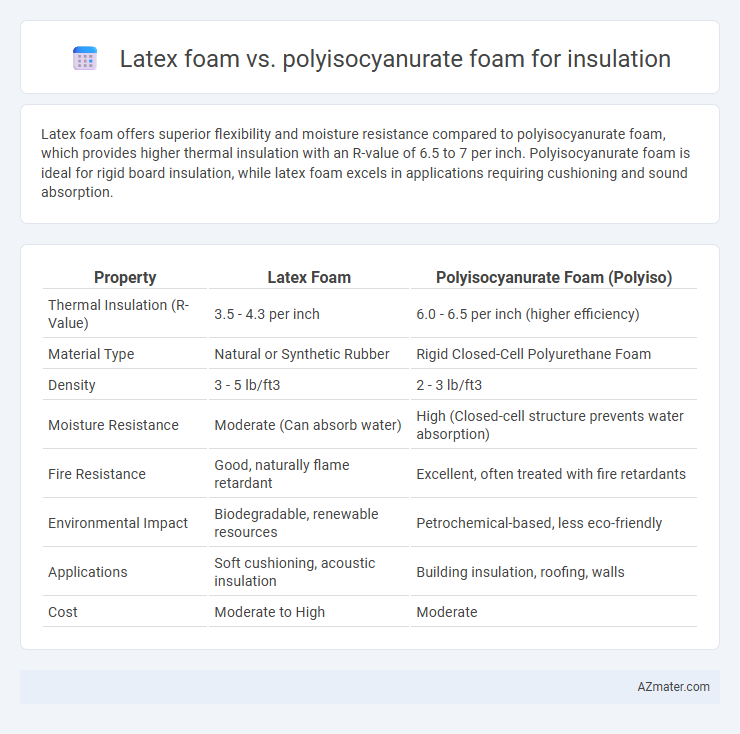Latex foam offers superior flexibility and moisture resistance compared to polyisocyanurate foam, which provides higher thermal insulation with an R-value of 6.5 to 7 per inch. Polyisocyanurate foam is ideal for rigid board insulation, while latex foam excels in applications requiring cushioning and sound absorption.
Table of Comparison
| Property | Latex Foam | Polyisocyanurate Foam (Polyiso) |
|---|---|---|
| Thermal Insulation (R-Value) | 3.5 - 4.3 per inch | 6.0 - 6.5 per inch (higher efficiency) |
| Material Type | Natural or Synthetic Rubber | Rigid Closed-Cell Polyurethane Foam |
| Density | 3 - 5 lb/ft3 | 2 - 3 lb/ft3 |
| Moisture Resistance | Moderate (Can absorb water) | High (Closed-cell structure prevents water absorption) |
| Fire Resistance | Good, naturally flame retardant | Excellent, often treated with fire retardants |
| Environmental Impact | Biodegradable, renewable resources | Petrochemical-based, less eco-friendly |
| Applications | Soft cushioning, acoustic insulation | Building insulation, roofing, walls |
| Cost | Moderate to High | Moderate |
Introduction to Latex Foam and Polyisocyanurate Foam
Latex foam, derived from natural or synthetic rubber, offers flexible, resilient insulation properties with excellent sound absorption and thermal regulation. Polyisocyanurate foam, a closed-cell rigid foam, provides superior thermal resistance due to its high R-value per inch, commonly used in roofing and wall insulation. Both foams serve distinct insulation needs, with latex foam favoring elasticity and comfort, while polyisocyanurate foam excels in durability and thermal efficiency.
Chemical Composition and Structure Comparison
Latex foam derives its structure from natural or synthetic rubber polymers forming a resilient, open-cell matrix, promoting breathability and flexibility ideal for sound insulation and cushioning. Polyisocyanurate foam consists of rigid, closed-cell polyurethane polymers with a high cross-link density, enhancing thermal resistance and structural rigidity essential for energy-efficient building insulation. The chemical composition of polyisocyanurate, rich in isocyanurate rings, contributes to superior fire resistance compared to the primarily protein-based polymers in latex foam.
Insulation Performance: R-Value Analysis
Latex foam typically offers an R-value of around 3 to 4 per inch, providing moderate thermal insulation suitable for residential applications. Polyisocyanurate foam delivers a higher R-value, often between 6 and 7 per inch, making it more effective for thermal resistance and energy efficiency in building envelopes. The superior R-value of polyisocyanurate foam translates to better insulation performance, reducing heat transfer and lowering heating and cooling costs compared to latex foam.
Thermal Conductivity Differences
Latex foam exhibits a thermal conductivity typically around 0.035 W/m*K, providing moderate insulation performance suitable for various applications. Polyisocyanurate (PIR) foam offers significantly lower thermal conductivity values, often ranging between 0.020 and 0.024 W/m*K, which translates to higher thermal resistance and better energy efficiency in building insulation. The lower thermal conductivity of polyisocyanurate foam makes it a preferred choice for projects requiring superior insulation and reduced heat transfer.
Moisture Resistance and Water Absorption
Latex foam offers excellent moisture resistance due to its closed-cell structure, resulting in low water absorption and minimal risk of mold growth in insulation applications. Polyisocyanurate foam also provides strong moisture resistance with a high closed-cell content, but it may absorb slightly more water over time if exposed to prolonged moisture. Both materials deliver reliable insulation performance, yet latex foam is generally preferred in environments where superior moisture resistance and reduced water uptake are critical.
Fire Resistance and Safety Ratings
Latex foam exhibits moderate fire resistance but typically requires additional fire retardants to meet strict safety standards, while polyisocyanurate foam boasts superior fire resistance with higher ASTM E84 flame spread ratings, often achieving Class A fire ratings. Polyisocyanurate's closed-cell structure and inherent chemical composition contribute to its ability to slow fire propagation and reduce smoke production compared to latex foam. Fire safety codes often favor polyisocyanurate for insulation in commercial buildings due to its enhanced performance against ignition and flame spread.
Environmental Impact and Sustainability
Latex foam, derived from natural rubber, offers a biodegradable and renewable insulation option with lower toxicity and reduced greenhouse gas emissions compared to polyisocyanurate foam, which relies on petrochemical-based ingredients and hydrofluorocarbon blowing agents contributing to ozone depletion and global warming. The production and disposal of polyisocyanurate foam result in greater environmental burdens due to non-biodegradability and higher embodied energy, whereas latex foam supports circular economy principles through compostability and lower carbon footprint. Prioritizing sustainable insulation materials like latex foam aligns with green building standards such as LEED and WELL, promoting long-term ecological benefits and indoor air quality improvements.
Installation Process and Flexibility
Latex foam offers superior flexibility and is easier to cut and shape during the installation process, allowing for a snug fit in irregular spaces, whereas polyisocyanurate foam, while rigid and highly insulating, often requires precise measurements and special tools for installation. The flexible nature of latex foam reduces gaps and thermal bridging, enhancing overall insulation efficiency, while polyisocyanurate's rigidity can cause challenges in fitting around corners and complex structures. Installation speed and adaptability favor latex foam, especially in retrofit projects, whereas polyisocyanurate is preferred for uniform, flat surfaces demanding high R-values.
Longevity and Maintenance Requirements
Latex foam insulation offers exceptional durability with resistance to mold, mildew, and decay, ensuring a lifespan that can exceed 20 years with minimal maintenance. Polyisocyanurate foam provides high thermal insulation efficiency and excellent fire resistance but may require periodic inspection to address potential rigid panel degradation or moisture infiltration. Both materials offer longevity, yet latex foam generally demands less upkeep due to its flexible, moisture-resistant properties.
Cost Comparison and Value for Money
Latex foam insulation typically costs more upfront than polyisocyanurate foam due to its natural materials and durability but offers superior resilience and hypoallergenic properties. Polyisocyanurate foam provides higher R-value per inch, making it more cost-effective for maximizing insulation performance in limited spaces. Evaluating long-term energy savings and environmental impact highlights polyisocyanurate as offering better value for money in most commercial and residential insulation projects.

Infographic: Latex foam vs Polyisocyanurate foam for Insulation
 azmater.com
azmater.com